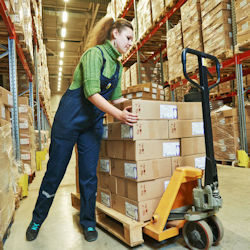Manual Lifting/Handling Hazards
Manual lifting and handling tasks in a warehouse setting present several common hazards, which can lead to injuries if proper precautions are not taken.
Here are some of the key hazards associated with manual lifting and handling:
- Overexertion: The most common hazard associated with manual lifting and handling is the frequent lifting of heavy or awkwardly shaped objects. This situation increases the risk of strained muscles, tendons, and ligaments, particularly in the lower back, shoulders, and knees.
- Repetitive Motions: Performing the same motions repeatedly, such as lifting, bending, or twisting, can lead to chronic injuries over time.
- Unsafe Surfaces: Carrying objects can obstruct vision, increasing the risk of slipping, tripping, or falling, especially if the floor is uneven, slippery, or cluttered.
- Struck by Falling Objects: Improperly handling items stored at height can cause them to fall, posing a risk to the handler and nearby workers.
- Object with Sharp Edges: Handling items with sharp edges or rough surfaces without proper protection can lead to cuts and bruises.
- Poor Posture: Lifting or carrying objects incorrectly can lead to poor posture and subsequent strain or injury.
- Collisions: Carrying large or bulky items can lead to collisions with objects, equipment, or other workers, resulting in impact injuries.
- Excessive Workload: Manual handling, especially if heavy or done over extended periods, can lead to general fatigue, reducing alertness and increasing the risk of accidents.
- Improper Lifting and Carrying: Awkward lifting and carrying techniques can put undue stress on joints, leading to acute or chronic joint injuries.
Real-life Accident
Employee Killed After Being Struck by Lifting Fixture
At 8:45 p.m. on April 7, 2021, an employee and a coworker were hanging steel I-beams via a universal lifting fixture (ULF) attached to a forklift in preparation for galvanization. After they finished hanging the materials, the forklift they were using was resting on its tines and caused the ULF to sway and fall off its stand. The ULF struck the employee causing multiple fractures.Knowledge Check Choose the best answer for the question.
1-7. What kind of injuries are most likely when performing manual lifting and handling in the warehouse?
You forgot to answer the question!

